HR Strategies for Employee Retention in UK Retail: A Unilever Study
VerifiedAdded on 2023/01/18
|11
|3328
|33
Report
AI Summary
This report delves into employee retention strategies within Unilever, focusing on the UK retail sector. It examines the current challenges of high employee turnover and retention, exploring factors like working environment, salary, training, and development. The research investigates the concept of employee retention, strategies employed by HR managers, and the challenges they face. The methodology includes both primary and secondary data collection, utilizing inductive approaches. The report aims to evaluate Unilever's HR strategies, identify areas for improvement, and recommend best practices for enhancing employee retention, ultimately contributing to the company's competitive advantage and providing insights for the retail sector. The literature review covers themes like the concept of employee retention, HR strategies, and the challenges HR faces in maintaining employee interest. The research methodology discusses the research approach, data collection methods, and sampling techniques employed in the study. The report also includes a statement of ethics and a timeline for the research.
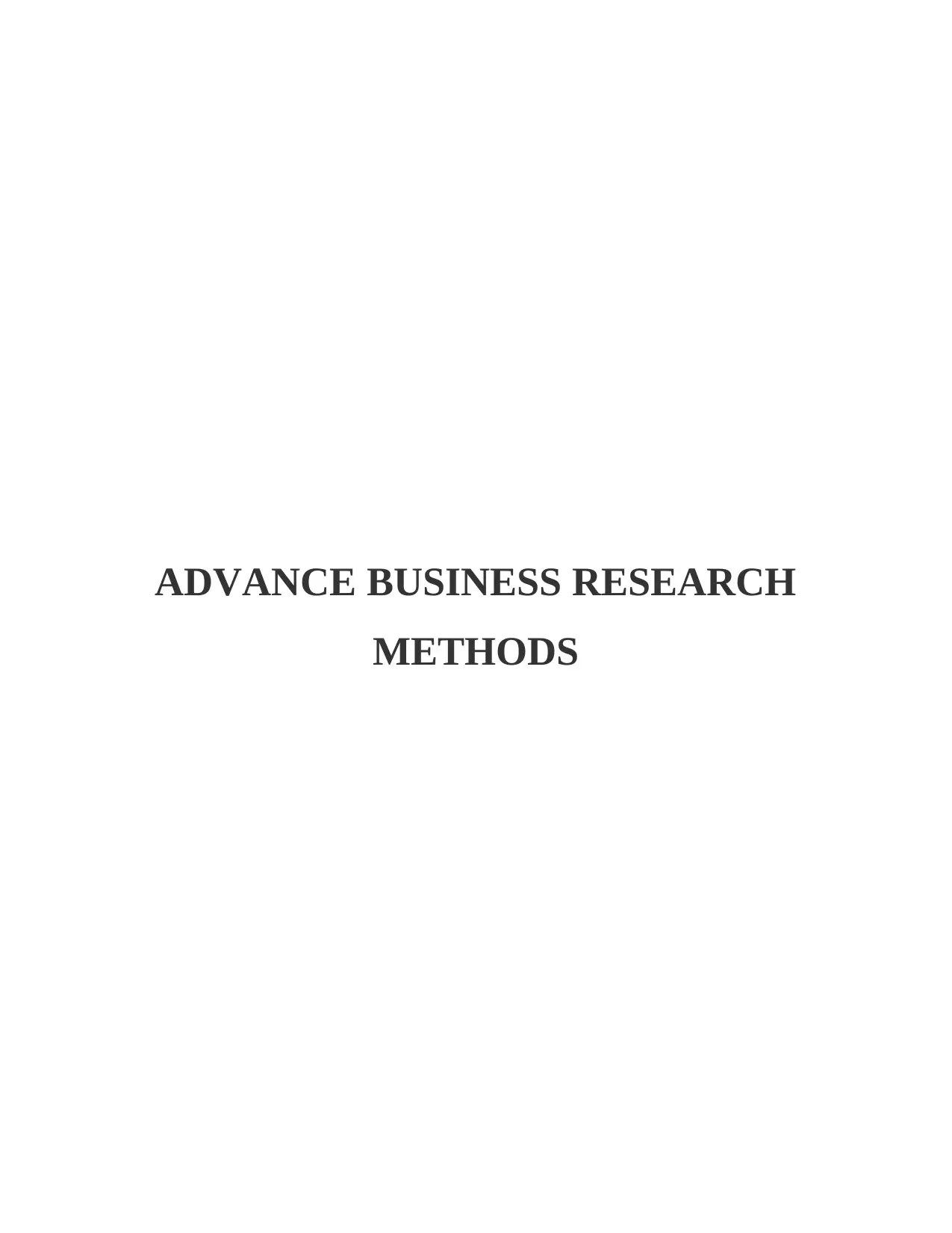
ADVANCE BUSINESS RESEARCH
METHODS
METHODS
Paraphrase This Document
Need a fresh take? Get an instant paraphrase of this document with our AI Paraphraser
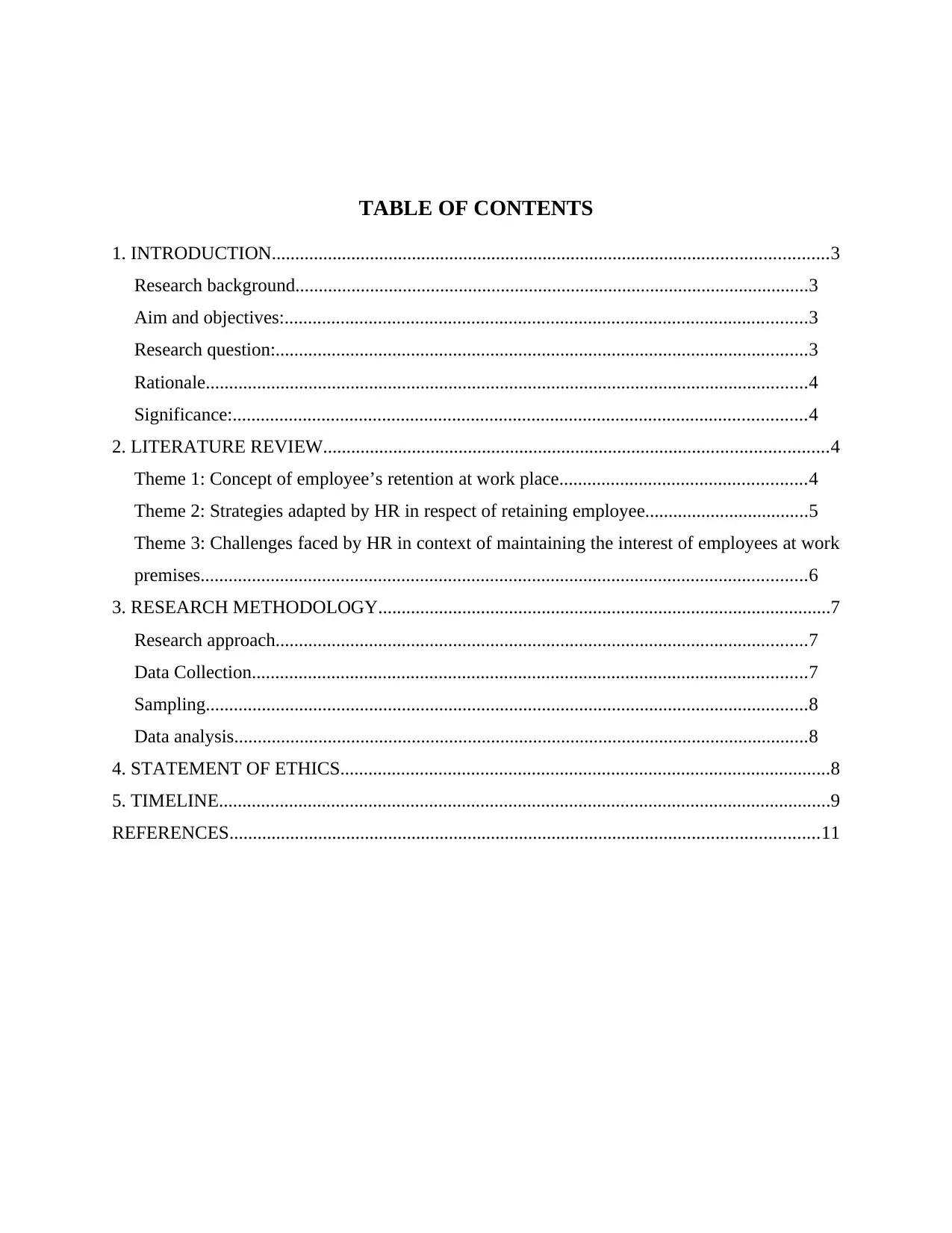
TABLE OF CONTENTS
1. INTRODUCTION.......................................................................................................................3
Research background..............................................................................................................3
Aim and objectives:................................................................................................................3
Research question:..................................................................................................................3
Rationale.................................................................................................................................4
Significance:...........................................................................................................................4
2. LITERATURE REVIEW............................................................................................................4
Theme 1: Concept of employee’s retention at work place.....................................................4
Theme 2: Strategies adapted by HR in respect of retaining employee...................................5
Theme 3: Challenges faced by HR in context of maintaining the interest of employees at work
premises..................................................................................................................................6
3. RESEARCH METHODOLOGY.................................................................................................7
Research approach..................................................................................................................7
Data Collection.......................................................................................................................7
Sampling.................................................................................................................................8
Data analysis...........................................................................................................................8
4. STATEMENT OF ETHICS.........................................................................................................8
5. TIMELINE...................................................................................................................................9
REFERENCES..............................................................................................................................11
1. INTRODUCTION.......................................................................................................................3
Research background..............................................................................................................3
Aim and objectives:................................................................................................................3
Research question:..................................................................................................................3
Rationale.................................................................................................................................4
Significance:...........................................................................................................................4
2. LITERATURE REVIEW............................................................................................................4
Theme 1: Concept of employee’s retention at work place.....................................................4
Theme 2: Strategies adapted by HR in respect of retaining employee...................................5
Theme 3: Challenges faced by HR in context of maintaining the interest of employees at work
premises..................................................................................................................................6
3. RESEARCH METHODOLOGY.................................................................................................7
Research approach..................................................................................................................7
Data Collection.......................................................................................................................7
Sampling.................................................................................................................................8
Data analysis...........................................................................................................................8
4. STATEMENT OF ETHICS.........................................................................................................8
5. TIMELINE...................................................................................................................................9
REFERENCES..............................................................................................................................11
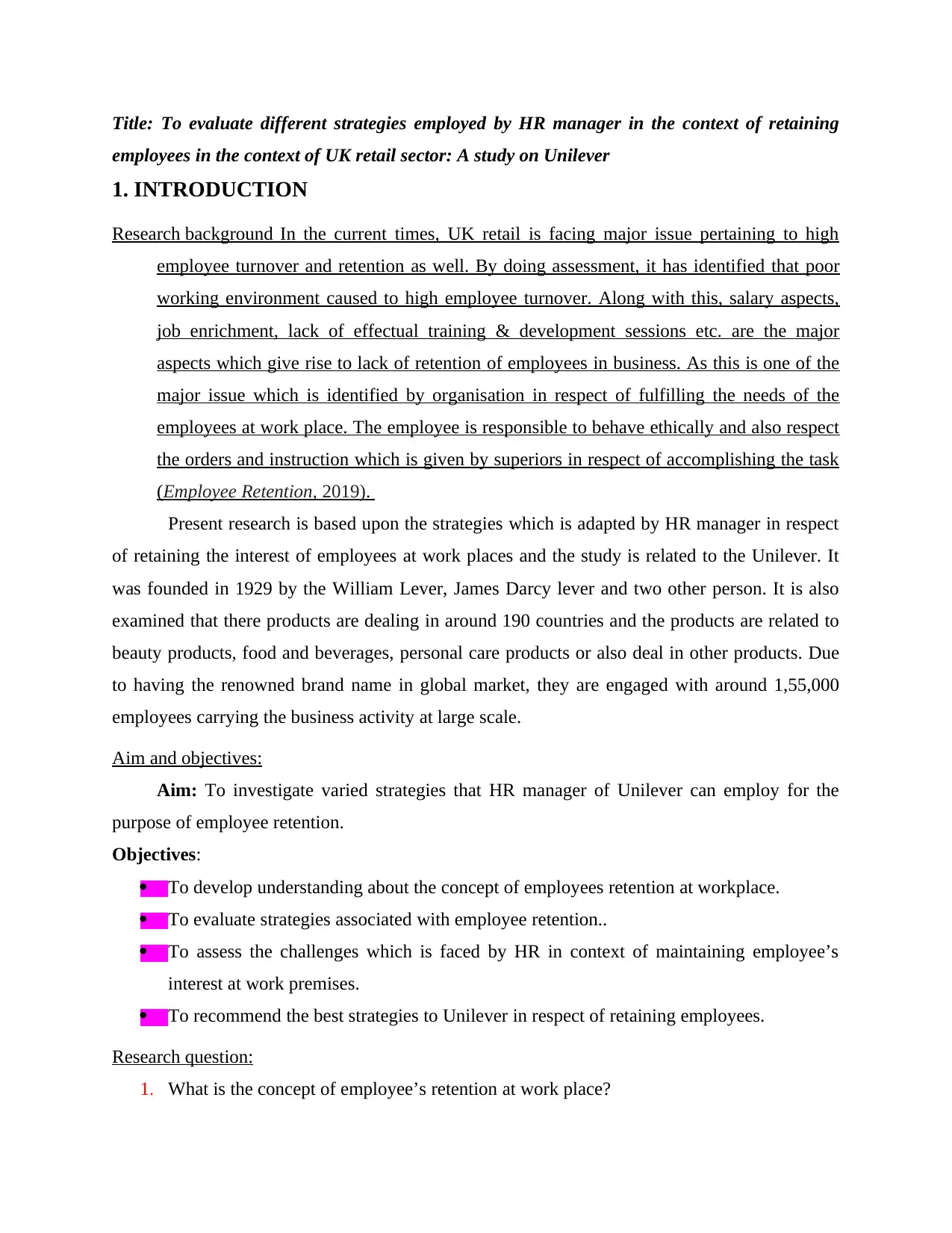
Title: To evaluate different strategies employed by HR manager in the context of retaining
employees in the context of UK retail sector: A study on Unilever
1. INTRODUCTION
Research background In the current times, UK retail is facing major issue pertaining to high
employee turnover and retention as well. By doing assessment, it has identified that poor
working environment caused to high employee turnover. Along with this, salary aspects,
job enrichment, lack of effectual training & development sessions etc. are the major
aspects which give rise to lack of retention of employees in business. As this is one of the
major issue which is identified by organisation in respect of fulfilling the needs of the
employees at work place. The employee is responsible to behave ethically and also respect
the orders and instruction which is given by superiors in respect of accomplishing the task
(Employee Retention, 2019).
Present research is based upon the strategies which is adapted by HR manager in respect
of retaining the interest of employees at work places and the study is related to the Unilever. It
was founded in 1929 by the William Lever, James Darcy lever and two other person. It is also
examined that there products are dealing in around 190 countries and the products are related to
beauty products, food and beverages, personal care products or also deal in other products. Due
to having the renowned brand name in global market, they are engaged with around 1,55,000
employees carrying the business activity at large scale.
Aim and objectives:
Aim: To investigate varied strategies that HR manager of Unilever can employ for the
purpose of employee retention.
Objectives:
To develop understanding about the concept of employees retention at workplace.
To evaluate strategies associated with employee retention..
To assess the challenges which is faced by HR in context of maintaining employee’s
interest at work premises.
To recommend the best strategies to Unilever in respect of retaining employees.
Research question:
1. What is the concept of employee’s retention at work place?
employees in the context of UK retail sector: A study on Unilever
1. INTRODUCTION
Research background In the current times, UK retail is facing major issue pertaining to high
employee turnover and retention as well. By doing assessment, it has identified that poor
working environment caused to high employee turnover. Along with this, salary aspects,
job enrichment, lack of effectual training & development sessions etc. are the major
aspects which give rise to lack of retention of employees in business. As this is one of the
major issue which is identified by organisation in respect of fulfilling the needs of the
employees at work place. The employee is responsible to behave ethically and also respect
the orders and instruction which is given by superiors in respect of accomplishing the task
(Employee Retention, 2019).
Present research is based upon the strategies which is adapted by HR manager in respect
of retaining the interest of employees at work places and the study is related to the Unilever. It
was founded in 1929 by the William Lever, James Darcy lever and two other person. It is also
examined that there products are dealing in around 190 countries and the products are related to
beauty products, food and beverages, personal care products or also deal in other products. Due
to having the renowned brand name in global market, they are engaged with around 1,55,000
employees carrying the business activity at large scale.
Aim and objectives:
Aim: To investigate varied strategies that HR manager of Unilever can employ for the
purpose of employee retention.
Objectives:
To develop understanding about the concept of employees retention at workplace.
To evaluate strategies associated with employee retention..
To assess the challenges which is faced by HR in context of maintaining employee’s
interest at work premises.
To recommend the best strategies to Unilever in respect of retaining employees.
Research question:
1. What is the concept of employee’s retention at work place?
⊘ This is a preview!⊘
Do you want full access?
Subscribe today to unlock all pages.

Trusted by 1+ million students worldwide
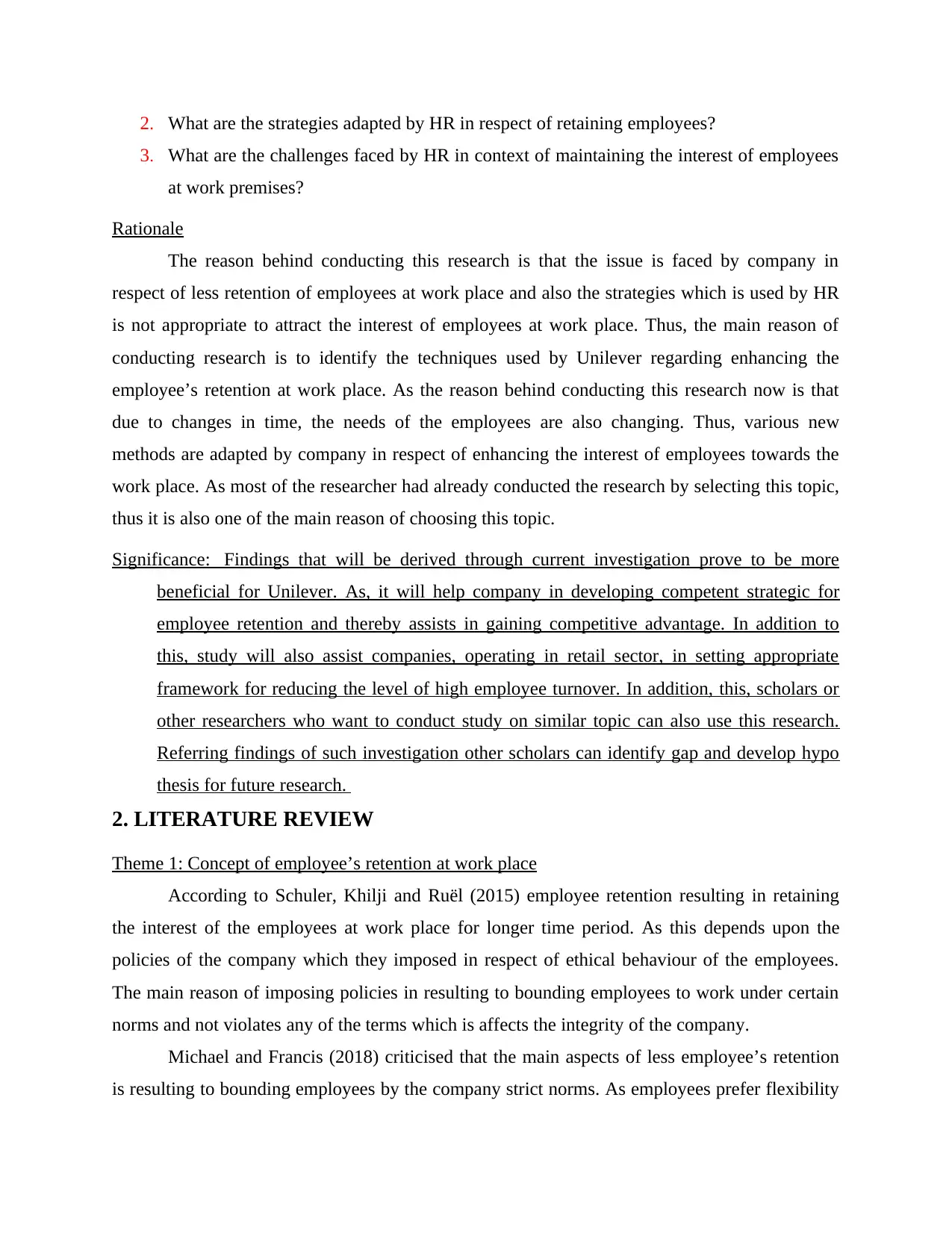
2. What are the strategies adapted by HR in respect of retaining employees?
3. What are the challenges faced by HR in context of maintaining the interest of employees
at work premises?
Rationale
The reason behind conducting this research is that the issue is faced by company in
respect of less retention of employees at work place and also the strategies which is used by HR
is not appropriate to attract the interest of employees at work place. Thus, the main reason of
conducting research is to identify the techniques used by Unilever regarding enhancing the
employee’s retention at work place. As the reason behind conducting this research now is that
due to changes in time, the needs of the employees are also changing. Thus, various new
methods are adapted by company in respect of enhancing the interest of employees towards the
work place. As most of the researcher had already conducted the research by selecting this topic,
thus it is also one of the main reason of choosing this topic.
Significance: Findings that will be derived through current investigation prove to be more
beneficial for Unilever. As, it will help company in developing competent strategic for
employee retention and thereby assists in gaining competitive advantage. In addition to
this, study will also assist companies, operating in retail sector, in setting appropriate
framework for reducing the level of high employee turnover. In addition, this, scholars or
other researchers who want to conduct study on similar topic can also use this research.
Referring findings of such investigation other scholars can identify gap and develop hypo
thesis for future research.
2. LITERATURE REVIEW
Theme 1: Concept of employee’s retention at work place
According to Schuler, Khilji and Ruël (2015) employee retention resulting in retaining
the interest of the employees at work place for longer time period. As this depends upon the
policies of the company which they imposed in respect of ethical behaviour of the employees.
The main reason of imposing policies in resulting to bounding employees to work under certain
norms and not violates any of the terms which is affects the integrity of the company.
Michael and Francis (2018) criticised that the main aspects of less employee’s retention
is resulting to bounding employees by the company strict norms. As employees prefer flexibility
3. What are the challenges faced by HR in context of maintaining the interest of employees
at work premises?
Rationale
The reason behind conducting this research is that the issue is faced by company in
respect of less retention of employees at work place and also the strategies which is used by HR
is not appropriate to attract the interest of employees at work place. Thus, the main reason of
conducting research is to identify the techniques used by Unilever regarding enhancing the
employee’s retention at work place. As the reason behind conducting this research now is that
due to changes in time, the needs of the employees are also changing. Thus, various new
methods are adapted by company in respect of enhancing the interest of employees towards the
work place. As most of the researcher had already conducted the research by selecting this topic,
thus it is also one of the main reason of choosing this topic.
Significance: Findings that will be derived through current investigation prove to be more
beneficial for Unilever. As, it will help company in developing competent strategic for
employee retention and thereby assists in gaining competitive advantage. In addition to
this, study will also assist companies, operating in retail sector, in setting appropriate
framework for reducing the level of high employee turnover. In addition, this, scholars or
other researchers who want to conduct study on similar topic can also use this research.
Referring findings of such investigation other scholars can identify gap and develop hypo
thesis for future research.
2. LITERATURE REVIEW
Theme 1: Concept of employee’s retention at work place
According to Schuler, Khilji and Ruël (2015) employee retention resulting in retaining
the interest of the employees at work place for longer time period. As this depends upon the
policies of the company which they imposed in respect of ethical behaviour of the employees.
The main reason of imposing policies in resulting to bounding employees to work under certain
norms and not violates any of the terms which is affects the integrity of the company.
Michael and Francis (2018) criticised that the main aspects of less employee’s retention
is resulting to bounding employees by the company strict norms. As employees prefer flexibility
Paraphrase This Document
Need a fresh take? Get an instant paraphrase of this document with our AI Paraphraser
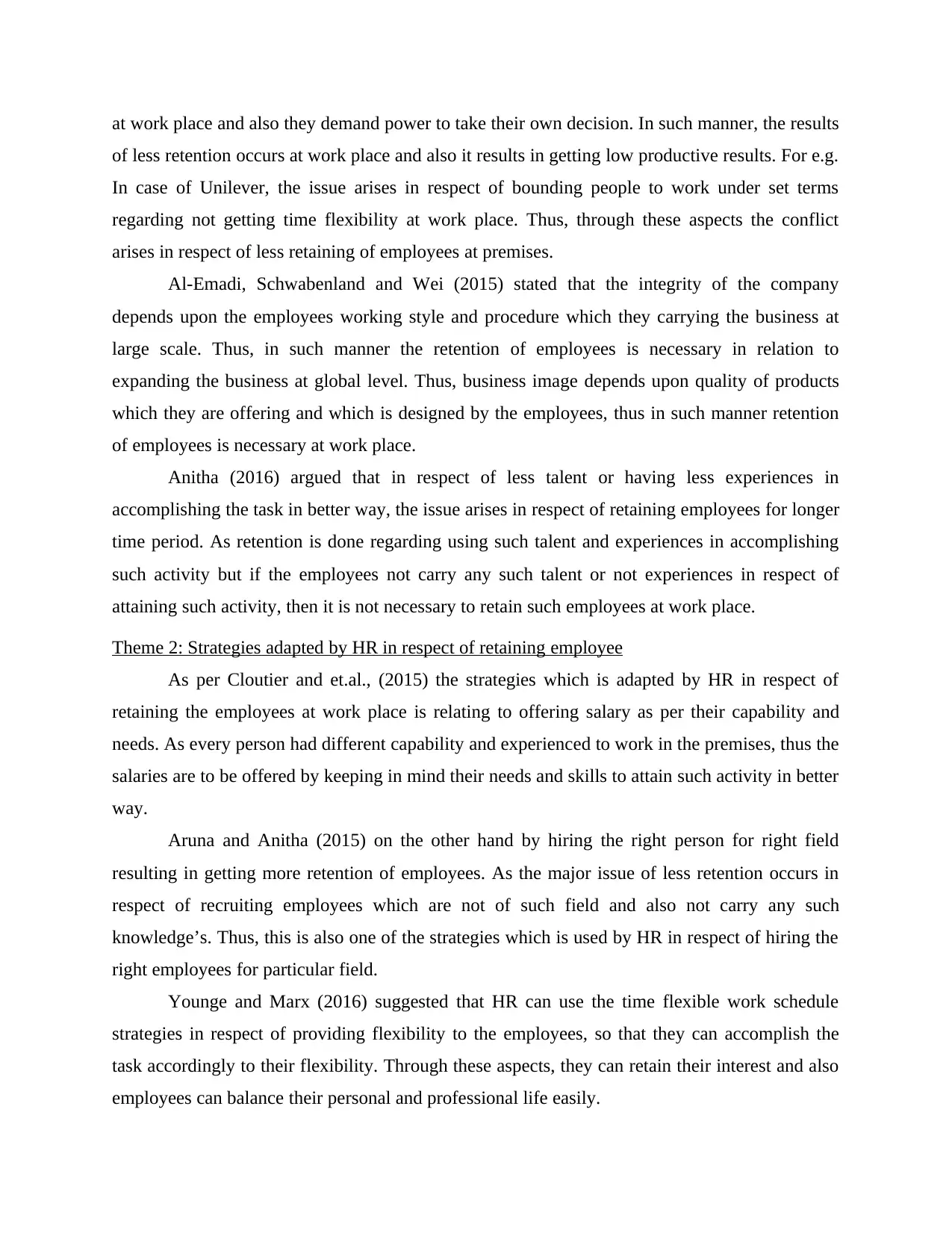
at work place and also they demand power to take their own decision. In such manner, the results
of less retention occurs at work place and also it results in getting low productive results. For e.g.
In case of Unilever, the issue arises in respect of bounding people to work under set terms
regarding not getting time flexibility at work place. Thus, through these aspects the conflict
arises in respect of less retaining of employees at premises.
Al-Emadi, Schwabenland and Wei (2015) stated that the integrity of the company
depends upon the employees working style and procedure which they carrying the business at
large scale. Thus, in such manner the retention of employees is necessary in relation to
expanding the business at global level. Thus, business image depends upon quality of products
which they are offering and which is designed by the employees, thus in such manner retention
of employees is necessary at work place.
Anitha (2016) argued that in respect of less talent or having less experiences in
accomplishing the task in better way, the issue arises in respect of retaining employees for longer
time period. As retention is done regarding using such talent and experiences in accomplishing
such activity but if the employees not carry any such talent or not experiences in respect of
attaining such activity, then it is not necessary to retain such employees at work place.
Theme 2: Strategies adapted by HR in respect of retaining employee
As per Cloutier and et.al., (2015) the strategies which is adapted by HR in respect of
retaining the employees at work place is relating to offering salary as per their capability and
needs. As every person had different capability and experienced to work in the premises, thus the
salaries are to be offered by keeping in mind their needs and skills to attain such activity in better
way.
Aruna and Anitha (2015) on the other hand by hiring the right person for right field
resulting in getting more retention of employees. As the major issue of less retention occurs in
respect of recruiting employees which are not of such field and also not carry any such
knowledge’s. Thus, this is also one of the strategies which is used by HR in respect of hiring the
right employees for particular field.
Younge and Marx (2016) suggested that HR can use the time flexible work schedule
strategies in respect of providing flexibility to the employees, so that they can accomplish the
task accordingly to their flexibility. Through these aspects, they can retain their interest and also
employees can balance their personal and professional life easily.
of less retention occurs at work place and also it results in getting low productive results. For e.g.
In case of Unilever, the issue arises in respect of bounding people to work under set terms
regarding not getting time flexibility at work place. Thus, through these aspects the conflict
arises in respect of less retaining of employees at premises.
Al-Emadi, Schwabenland and Wei (2015) stated that the integrity of the company
depends upon the employees working style and procedure which they carrying the business at
large scale. Thus, in such manner the retention of employees is necessary in relation to
expanding the business at global level. Thus, business image depends upon quality of products
which they are offering and which is designed by the employees, thus in such manner retention
of employees is necessary at work place.
Anitha (2016) argued that in respect of less talent or having less experiences in
accomplishing the task in better way, the issue arises in respect of retaining employees for longer
time period. As retention is done regarding using such talent and experiences in accomplishing
such activity but if the employees not carry any such talent or not experiences in respect of
attaining such activity, then it is not necessary to retain such employees at work place.
Theme 2: Strategies adapted by HR in respect of retaining employee
As per Cloutier and et.al., (2015) the strategies which is adapted by HR in respect of
retaining the employees at work place is relating to offering salary as per their capability and
needs. As every person had different capability and experienced to work in the premises, thus the
salaries are to be offered by keeping in mind their needs and skills to attain such activity in better
way.
Aruna and Anitha (2015) on the other hand by hiring the right person for right field
resulting in getting more retention of employees. As the major issue of less retention occurs in
respect of recruiting employees which are not of such field and also not carry any such
knowledge’s. Thus, this is also one of the strategies which is used by HR in respect of hiring the
right employees for particular field.
Younge and Marx (2016) suggested that HR can use the time flexible work schedule
strategies in respect of providing flexibility to the employees, so that they can accomplish the
task accordingly to their flexibility. Through these aspects, they can retain their interest and also
employees can balance their personal and professional life easily.
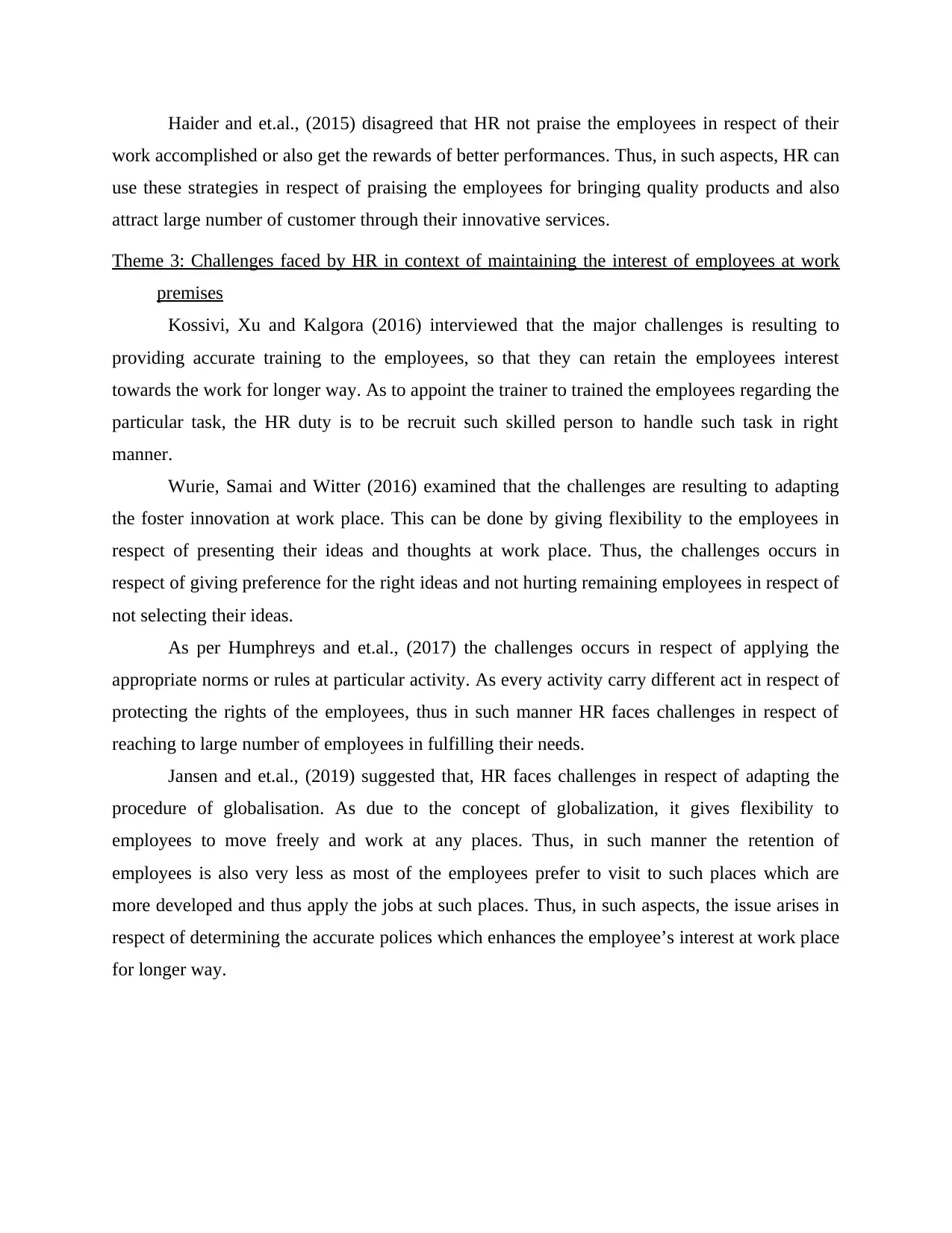
Haider and et.al., (2015) disagreed that HR not praise the employees in respect of their
work accomplished or also get the rewards of better performances. Thus, in such aspects, HR can
use these strategies in respect of praising the employees for bringing quality products and also
attract large number of customer through their innovative services.
Theme 3: Challenges faced by HR in context of maintaining the interest of employees at work
premises
Kossivi, Xu and Kalgora (2016) interviewed that the major challenges is resulting to
providing accurate training to the employees, so that they can retain the employees interest
towards the work for longer way. As to appoint the trainer to trained the employees regarding the
particular task, the HR duty is to be recruit such skilled person to handle such task in right
manner.
Wurie, Samai and Witter (2016) examined that the challenges are resulting to adapting
the foster innovation at work place. This can be done by giving flexibility to the employees in
respect of presenting their ideas and thoughts at work place. Thus, the challenges occurs in
respect of giving preference for the right ideas and not hurting remaining employees in respect of
not selecting their ideas.
As per Humphreys and et.al., (2017) the challenges occurs in respect of applying the
appropriate norms or rules at particular activity. As every activity carry different act in respect of
protecting the rights of the employees, thus in such manner HR faces challenges in respect of
reaching to large number of employees in fulfilling their needs.
Jansen and et.al., (2019) suggested that, HR faces challenges in respect of adapting the
procedure of globalisation. As due to the concept of globalization, it gives flexibility to
employees to move freely and work at any places. Thus, in such manner the retention of
employees is also very less as most of the employees prefer to visit to such places which are
more developed and thus apply the jobs at such places. Thus, in such aspects, the issue arises in
respect of determining the accurate polices which enhances the employee’s interest at work place
for longer way.
work accomplished or also get the rewards of better performances. Thus, in such aspects, HR can
use these strategies in respect of praising the employees for bringing quality products and also
attract large number of customer through their innovative services.
Theme 3: Challenges faced by HR in context of maintaining the interest of employees at work
premises
Kossivi, Xu and Kalgora (2016) interviewed that the major challenges is resulting to
providing accurate training to the employees, so that they can retain the employees interest
towards the work for longer way. As to appoint the trainer to trained the employees regarding the
particular task, the HR duty is to be recruit such skilled person to handle such task in right
manner.
Wurie, Samai and Witter (2016) examined that the challenges are resulting to adapting
the foster innovation at work place. This can be done by giving flexibility to the employees in
respect of presenting their ideas and thoughts at work place. Thus, the challenges occurs in
respect of giving preference for the right ideas and not hurting remaining employees in respect of
not selecting their ideas.
As per Humphreys and et.al., (2017) the challenges occurs in respect of applying the
appropriate norms or rules at particular activity. As every activity carry different act in respect of
protecting the rights of the employees, thus in such manner HR faces challenges in respect of
reaching to large number of employees in fulfilling their needs.
Jansen and et.al., (2019) suggested that, HR faces challenges in respect of adapting the
procedure of globalisation. As due to the concept of globalization, it gives flexibility to
employees to move freely and work at any places. Thus, in such manner the retention of
employees is also very less as most of the employees prefer to visit to such places which are
more developed and thus apply the jobs at such places. Thus, in such aspects, the issue arises in
respect of determining the accurate polices which enhances the employee’s interest at work place
for longer way.
⊘ This is a preview!⊘
Do you want full access?
Subscribe today to unlock all pages.

Trusted by 1+ million students worldwide
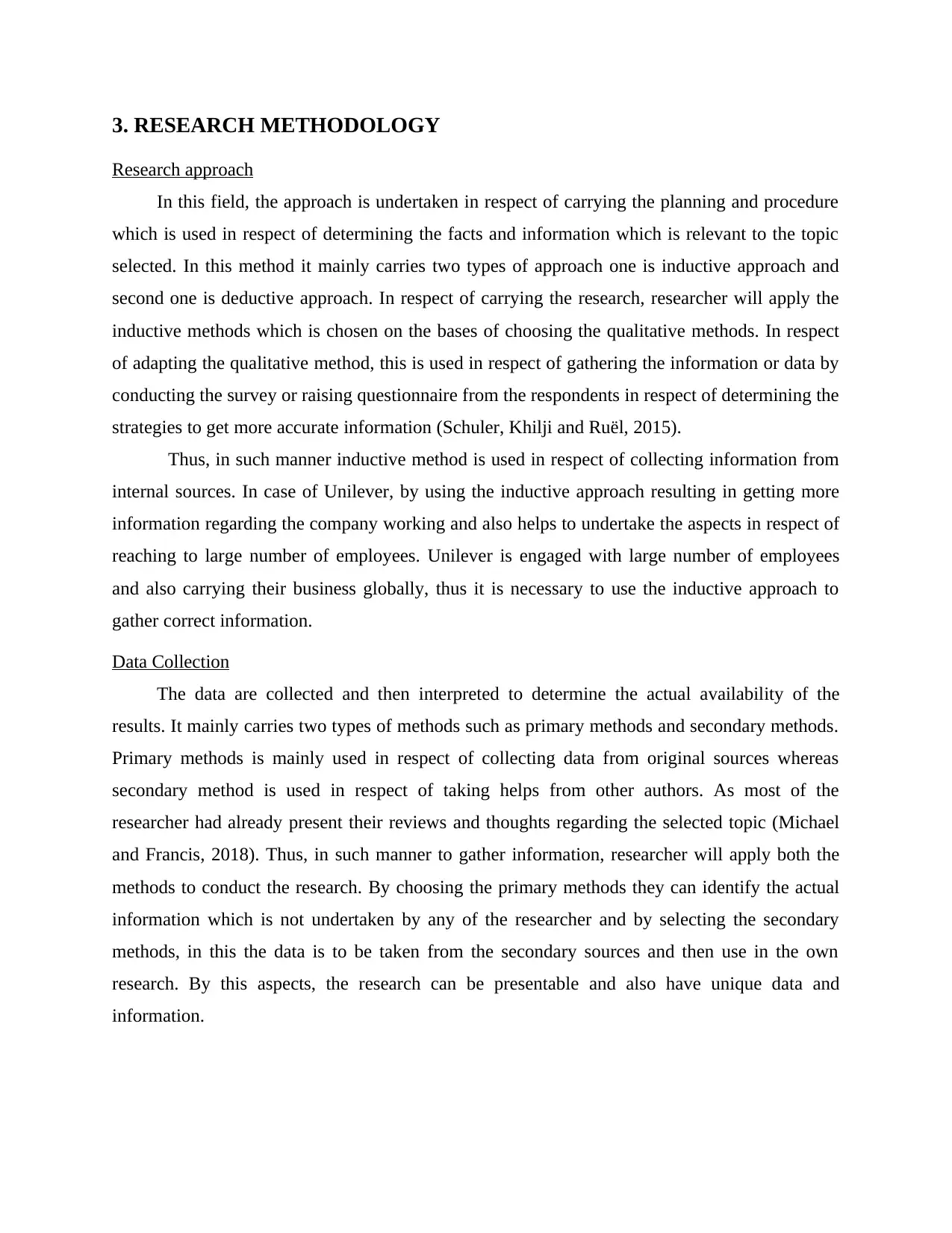
3. RESEARCH METHODOLOGY
Research approach
In this field, the approach is undertaken in respect of carrying the planning and procedure
which is used in respect of determining the facts and information which is relevant to the topic
selected. In this method it mainly carries two types of approach one is inductive approach and
second one is deductive approach. In respect of carrying the research, researcher will apply the
inductive methods which is chosen on the bases of choosing the qualitative methods. In respect
of adapting the qualitative method, this is used in respect of gathering the information or data by
conducting the survey or raising questionnaire from the respondents in respect of determining the
strategies to get more accurate information (Schuler, Khilji and Ruël, 2015).
Thus, in such manner inductive method is used in respect of collecting information from
internal sources. In case of Unilever, by using the inductive approach resulting in getting more
information regarding the company working and also helps to undertake the aspects in respect of
reaching to large number of employees. Unilever is engaged with large number of employees
and also carrying their business globally, thus it is necessary to use the inductive approach to
gather correct information.
Data Collection
The data are collected and then interpreted to determine the actual availability of the
results. It mainly carries two types of methods such as primary methods and secondary methods.
Primary methods is mainly used in respect of collecting data from original sources whereas
secondary method is used in respect of taking helps from other authors. As most of the
researcher had already present their reviews and thoughts regarding the selected topic (Michael
and Francis, 2018). Thus, in such manner to gather information, researcher will apply both the
methods to conduct the research. By choosing the primary methods they can identify the actual
information which is not undertaken by any of the researcher and by selecting the secondary
methods, in this the data is to be taken from the secondary sources and then use in the own
research. By this aspects, the research can be presentable and also have unique data and
information.
Research approach
In this field, the approach is undertaken in respect of carrying the planning and procedure
which is used in respect of determining the facts and information which is relevant to the topic
selected. In this method it mainly carries two types of approach one is inductive approach and
second one is deductive approach. In respect of carrying the research, researcher will apply the
inductive methods which is chosen on the bases of choosing the qualitative methods. In respect
of adapting the qualitative method, this is used in respect of gathering the information or data by
conducting the survey or raising questionnaire from the respondents in respect of determining the
strategies to get more accurate information (Schuler, Khilji and Ruël, 2015).
Thus, in such manner inductive method is used in respect of collecting information from
internal sources. In case of Unilever, by using the inductive approach resulting in getting more
information regarding the company working and also helps to undertake the aspects in respect of
reaching to large number of employees. Unilever is engaged with large number of employees
and also carrying their business globally, thus it is necessary to use the inductive approach to
gather correct information.
Data Collection
The data are collected and then interpreted to determine the actual availability of the
results. It mainly carries two types of methods such as primary methods and secondary methods.
Primary methods is mainly used in respect of collecting data from original sources whereas
secondary method is used in respect of taking helps from other authors. As most of the
researcher had already present their reviews and thoughts regarding the selected topic (Michael
and Francis, 2018). Thus, in such manner to gather information, researcher will apply both the
methods to conduct the research. By choosing the primary methods they can identify the actual
information which is not undertaken by any of the researcher and by selecting the secondary
methods, in this the data is to be taken from the secondary sources and then use in the own
research. By this aspects, the research can be presentable and also have unique data and
information.
Paraphrase This Document
Need a fresh take? Get an instant paraphrase of this document with our AI Paraphraser
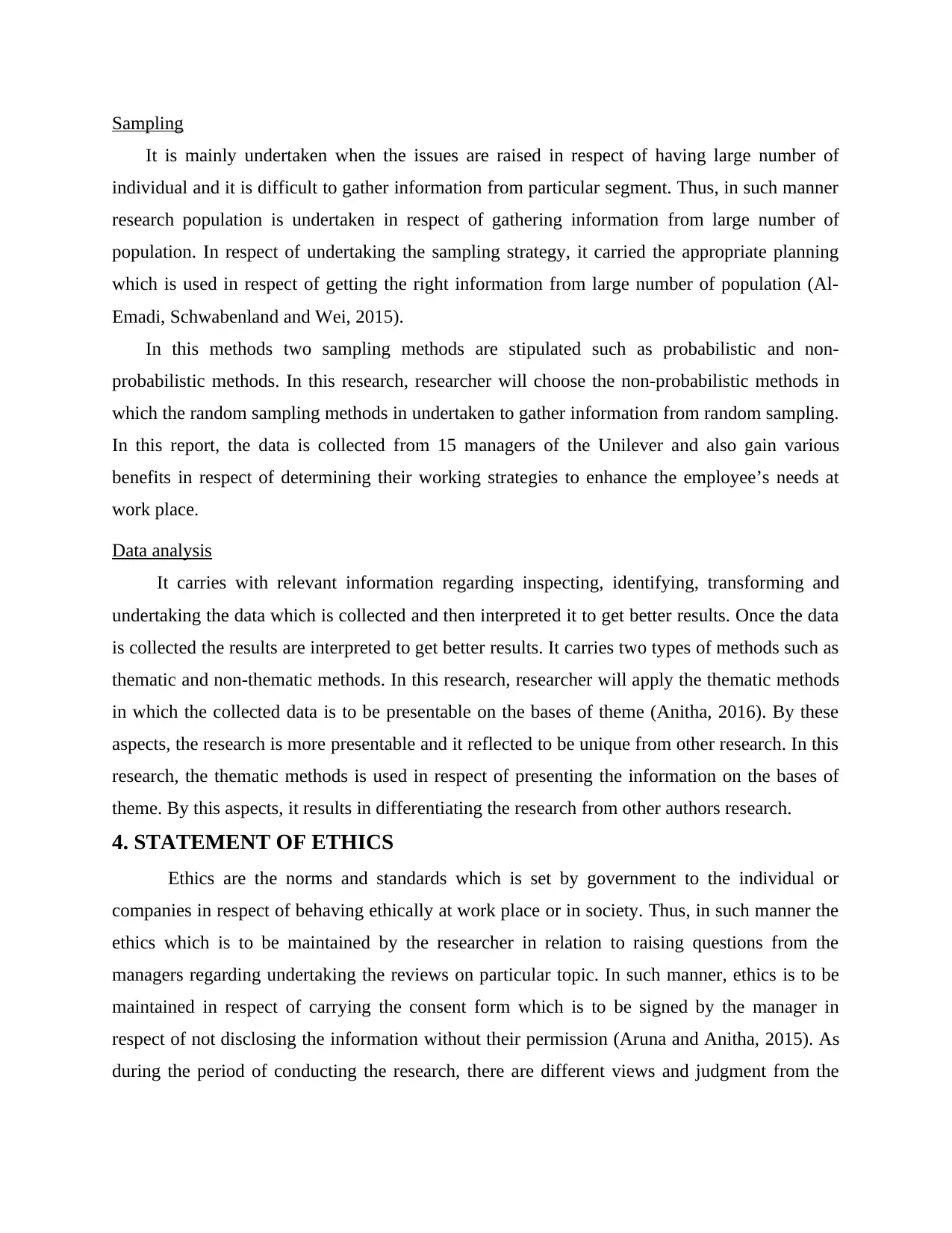
Sampling
It is mainly undertaken when the issues are raised in respect of having large number of
individual and it is difficult to gather information from particular segment. Thus, in such manner
research population is undertaken in respect of gathering information from large number of
population. In respect of undertaking the sampling strategy, it carried the appropriate planning
which is used in respect of getting the right information from large number of population (Al-
Emadi, Schwabenland and Wei, 2015).
In this methods two sampling methods are stipulated such as probabilistic and non-
probabilistic methods. In this research, researcher will choose the non-probabilistic methods in
which the random sampling methods in undertaken to gather information from random sampling.
In this report, the data is collected from 15 managers of the Unilever and also gain various
benefits in respect of determining their working strategies to enhance the employee’s needs at
work place.
Data analysis
It carries with relevant information regarding inspecting, identifying, transforming and
undertaking the data which is collected and then interpreted it to get better results. Once the data
is collected the results are interpreted to get better results. It carries two types of methods such as
thematic and non-thematic methods. In this research, researcher will apply the thematic methods
in which the collected data is to be presentable on the bases of theme (Anitha, 2016). By these
aspects, the research is more presentable and it reflected to be unique from other research. In this
research, the thematic methods is used in respect of presenting the information on the bases of
theme. By this aspects, it results in differentiating the research from other authors research.
4. STATEMENT OF ETHICS
Ethics are the norms and standards which is set by government to the individual or
companies in respect of behaving ethically at work place or in society. Thus, in such manner the
ethics which is to be maintained by the researcher in relation to raising questions from the
managers regarding undertaking the reviews on particular topic. In such manner, ethics is to be
maintained in respect of carrying the consent form which is to be signed by the manager in
respect of not disclosing the information without their permission (Aruna and Anitha, 2015). As
during the period of conducting the research, there are different views and judgment from the
It is mainly undertaken when the issues are raised in respect of having large number of
individual and it is difficult to gather information from particular segment. Thus, in such manner
research population is undertaken in respect of gathering information from large number of
population. In respect of undertaking the sampling strategy, it carried the appropriate planning
which is used in respect of getting the right information from large number of population (Al-
Emadi, Schwabenland and Wei, 2015).
In this methods two sampling methods are stipulated such as probabilistic and non-
probabilistic methods. In this research, researcher will choose the non-probabilistic methods in
which the random sampling methods in undertaken to gather information from random sampling.
In this report, the data is collected from 15 managers of the Unilever and also gain various
benefits in respect of determining their working strategies to enhance the employee’s needs at
work place.
Data analysis
It carries with relevant information regarding inspecting, identifying, transforming and
undertaking the data which is collected and then interpreted it to get better results. Once the data
is collected the results are interpreted to get better results. It carries two types of methods such as
thematic and non-thematic methods. In this research, researcher will apply the thematic methods
in which the collected data is to be presentable on the bases of theme (Anitha, 2016). By these
aspects, the research is more presentable and it reflected to be unique from other research. In this
research, the thematic methods is used in respect of presenting the information on the bases of
theme. By this aspects, it results in differentiating the research from other authors research.
4. STATEMENT OF ETHICS
Ethics are the norms and standards which is set by government to the individual or
companies in respect of behaving ethically at work place or in society. Thus, in such manner the
ethics which is to be maintained by the researcher in relation to raising questions from the
managers regarding undertaking the reviews on particular topic. In such manner, ethics is to be
maintained in respect of carrying the consent form which is to be signed by the manager in
respect of not disclosing the information without their permission (Aruna and Anitha, 2015). As
during the period of conducting the research, there are different views and judgment from the
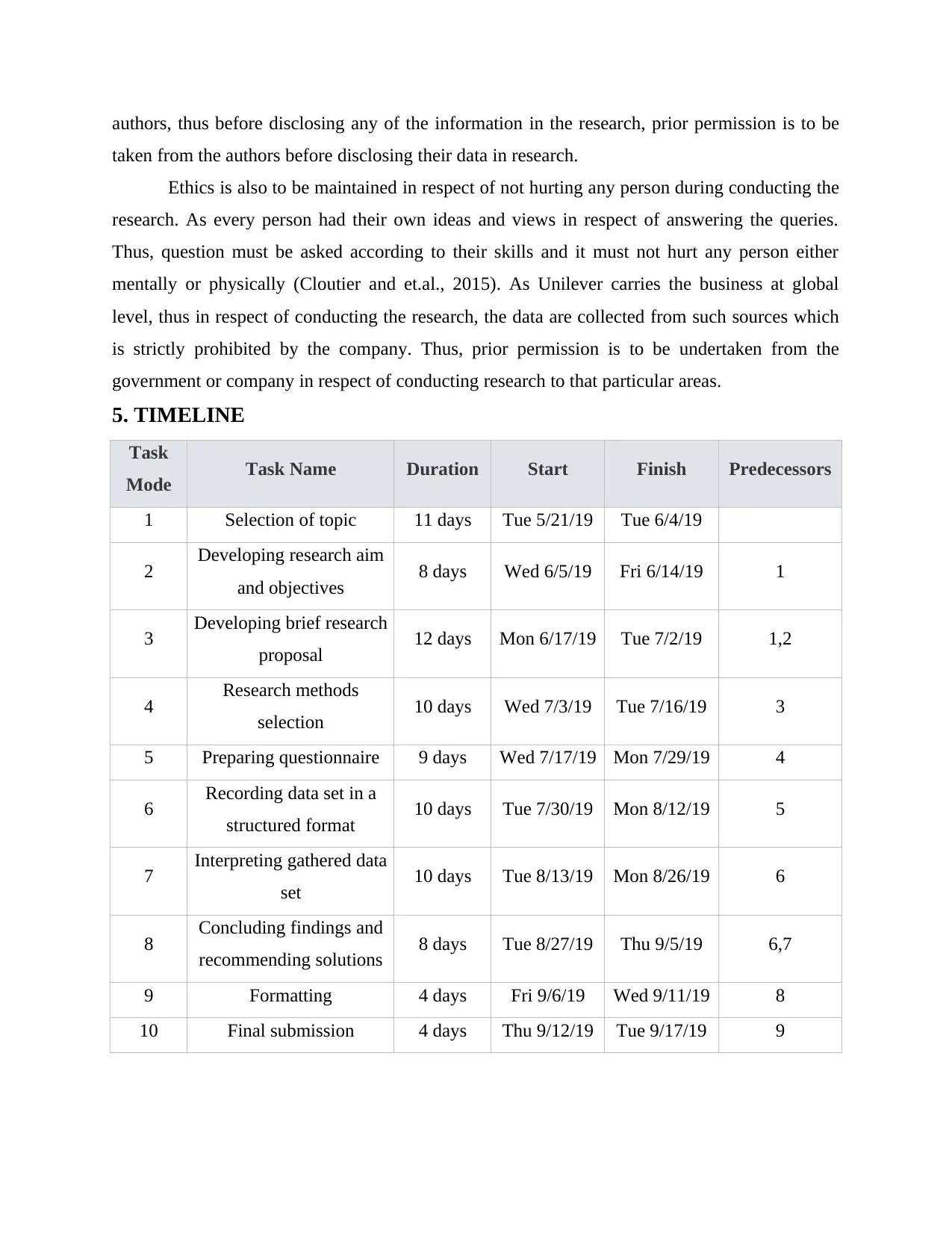
authors, thus before disclosing any of the information in the research, prior permission is to be
taken from the authors before disclosing their data in research.
Ethics is also to be maintained in respect of not hurting any person during conducting the
research. As every person had their own ideas and views in respect of answering the queries.
Thus, question must be asked according to their skills and it must not hurt any person either
mentally or physically (Cloutier and et.al., 2015). As Unilever carries the business at global
level, thus in respect of conducting the research, the data are collected from such sources which
is strictly prohibited by the company. Thus, prior permission is to be undertaken from the
government or company in respect of conducting research to that particular areas.
5. TIMELINE
Task
Mode Task Name Duration Start Finish Predecessors
1 Selection of topic 11 days Tue 5/21/19 Tue 6/4/19
2 Developing research aim
and objectives 8 days Wed 6/5/19 Fri 6/14/19 1
3 Developing brief research
proposal 12 days Mon 6/17/19 Tue 7/2/19 1,2
4 Research methods
selection 10 days Wed 7/3/19 Tue 7/16/19 3
5 Preparing questionnaire 9 days Wed 7/17/19 Mon 7/29/19 4
6 Recording data set in a
structured format 10 days Tue 7/30/19 Mon 8/12/19 5
7 Interpreting gathered data
set 10 days Tue 8/13/19 Mon 8/26/19 6
8 Concluding findings and
recommending solutions 8 days Tue 8/27/19 Thu 9/5/19 6,7
9 Formatting 4 days Fri 9/6/19 Wed 9/11/19 8
10 Final submission 4 days Thu 9/12/19 Tue 9/17/19 9
taken from the authors before disclosing their data in research.
Ethics is also to be maintained in respect of not hurting any person during conducting the
research. As every person had their own ideas and views in respect of answering the queries.
Thus, question must be asked according to their skills and it must not hurt any person either
mentally or physically (Cloutier and et.al., 2015). As Unilever carries the business at global
level, thus in respect of conducting the research, the data are collected from such sources which
is strictly prohibited by the company. Thus, prior permission is to be undertaken from the
government or company in respect of conducting research to that particular areas.
5. TIMELINE
Task
Mode Task Name Duration Start Finish Predecessors
1 Selection of topic 11 days Tue 5/21/19 Tue 6/4/19
2 Developing research aim
and objectives 8 days Wed 6/5/19 Fri 6/14/19 1
3 Developing brief research
proposal 12 days Mon 6/17/19 Tue 7/2/19 1,2
4 Research methods
selection 10 days Wed 7/3/19 Tue 7/16/19 3
5 Preparing questionnaire 9 days Wed 7/17/19 Mon 7/29/19 4
6 Recording data set in a
structured format 10 days Tue 7/30/19 Mon 8/12/19 5
7 Interpreting gathered data
set 10 days Tue 8/13/19 Mon 8/26/19 6
8 Concluding findings and
recommending solutions 8 days Tue 8/27/19 Thu 9/5/19 6,7
9 Formatting 4 days Fri 9/6/19 Wed 9/11/19 8
10 Final submission 4 days Thu 9/12/19 Tue 9/17/19 9
⊘ This is a preview!⊘
Do you want full access?
Subscribe today to unlock all pages.

Trusted by 1+ million students worldwide
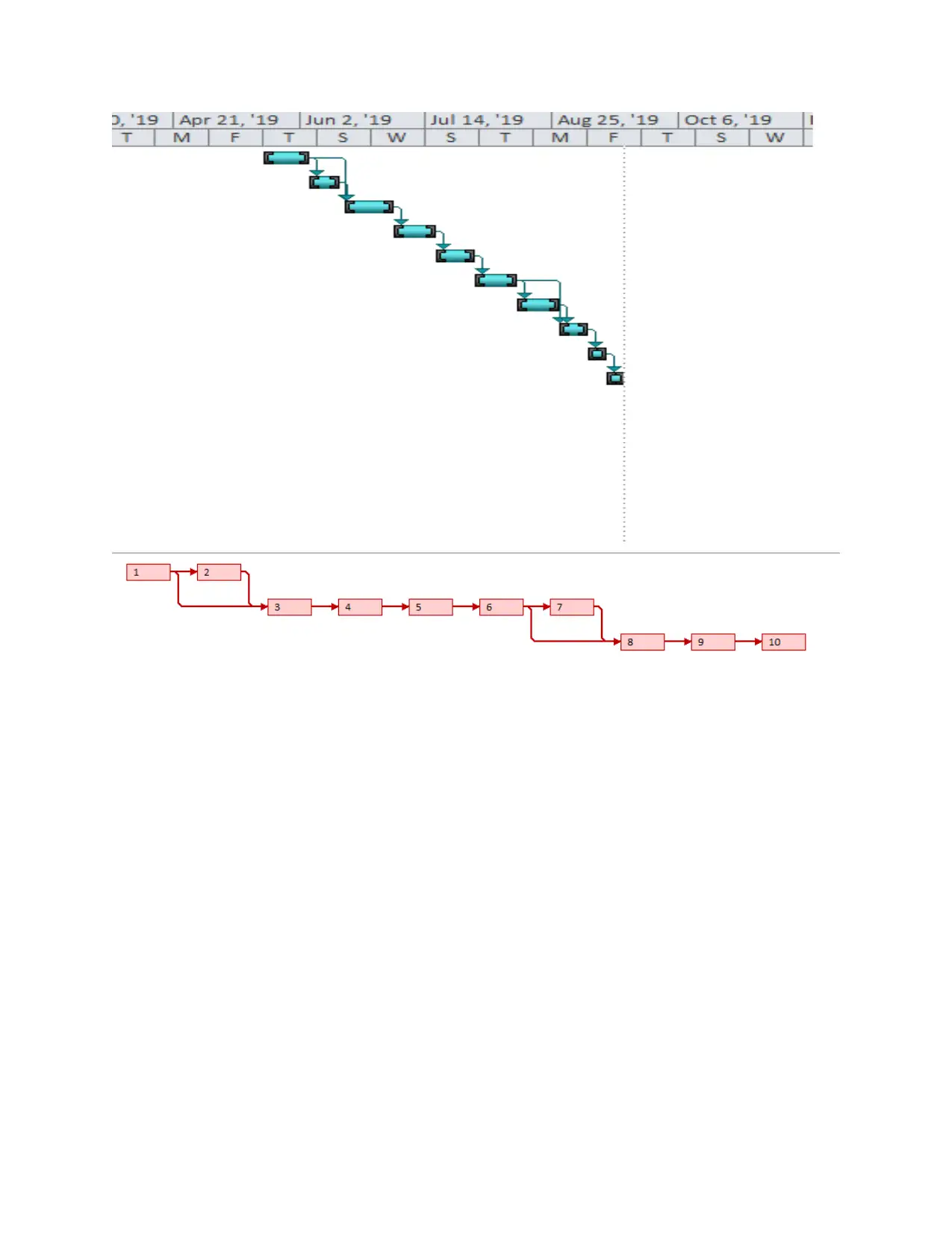
Paraphrase This Document
Need a fresh take? Get an instant paraphrase of this document with our AI Paraphraser
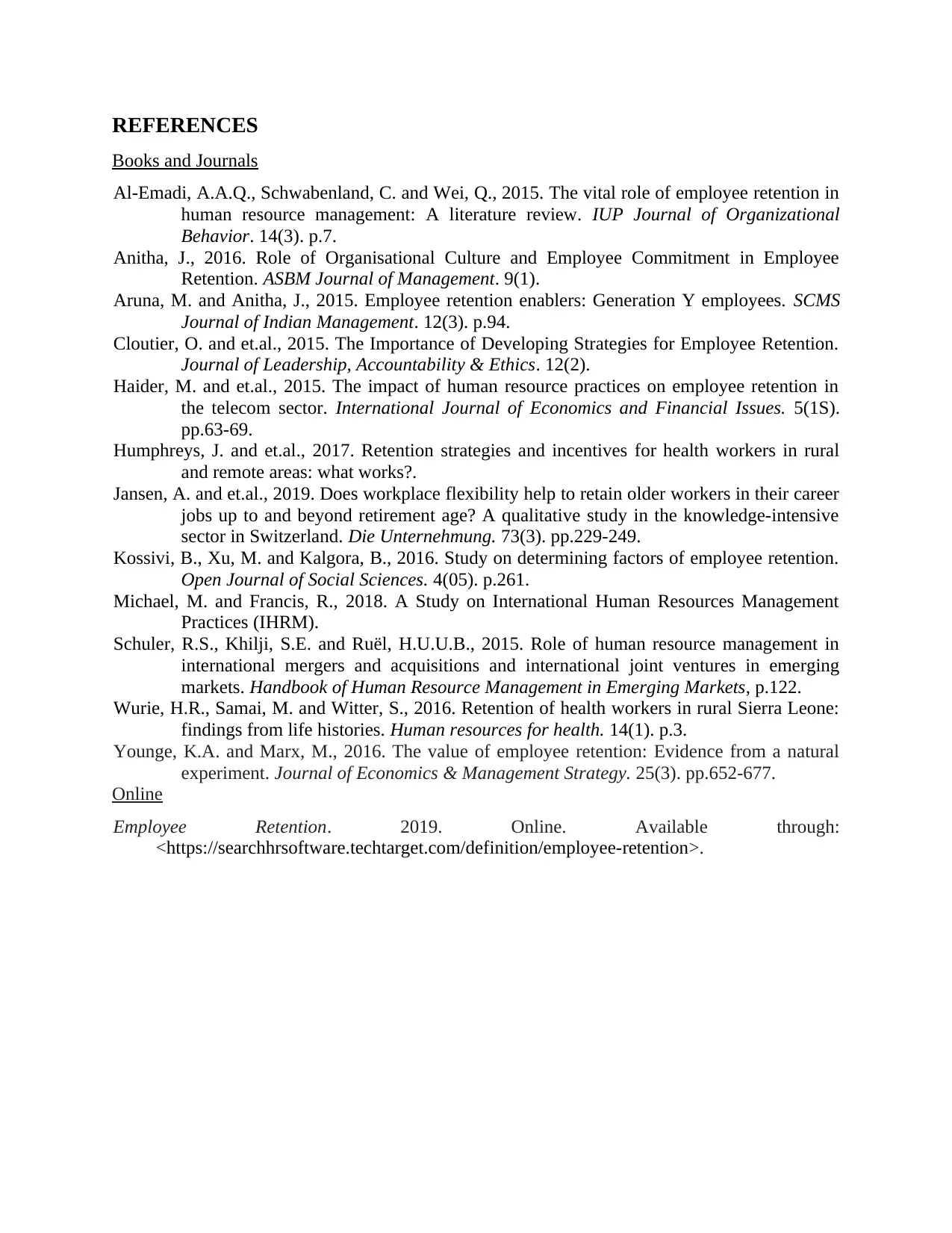
REFERENCES
Books and Journals
Al-Emadi, A.A.Q., Schwabenland, C. and Wei, Q., 2015. The vital role of employee retention in
human resource management: A literature review. IUP Journal of Organizational
Behavior. 14(3). p.7.
Anitha, J., 2016. Role of Organisational Culture and Employee Commitment in Employee
Retention. ASBM Journal of Management. 9(1).
Aruna, M. and Anitha, J., 2015. Employee retention enablers: Generation Y employees. SCMS
Journal of Indian Management. 12(3). p.94.
Cloutier, O. and et.al., 2015. The Importance of Developing Strategies for Employee Retention.
Journal of Leadership, Accountability & Ethics. 12(2).
Haider, M. and et.al., 2015. The impact of human resource practices on employee retention in
the telecom sector. International Journal of Economics and Financial Issues. 5(1S).
pp.63-69.
Humphreys, J. and et.al., 2017. Retention strategies and incentives for health workers in rural
and remote areas: what works?.
Jansen, A. and et.al., 2019. Does workplace flexibility help to retain older workers in their career
jobs up to and beyond retirement age? A qualitative study in the knowledge-intensive
sector in Switzerland. Die Unternehmung. 73(3). pp.229-249.
Kossivi, B., Xu, M. and Kalgora, B., 2016. Study on determining factors of employee retention.
Open Journal of Social Sciences. 4(05). p.261.
Michael, M. and Francis, R., 2018. A Study on International Human Resources Management
Practices (IHRM).
Schuler, R.S., Khilji, S.E. and Ruël, H.U.U.B., 2015. Role of human resource management in
international mergers and acquisitions and international joint ventures in emerging
markets. Handbook of Human Resource Management in Emerging Markets, p.122.
Wurie, H.R., Samai, M. and Witter, S., 2016. Retention of health workers in rural Sierra Leone:
findings from life histories. Human resources for health. 14(1). p.3.
Younge, K.A. and Marx, M., 2016. The value of employee retention: Evidence from a natural
experiment. Journal of Economics & Management Strategy. 25(3). pp.652-677.
Online
Employee Retention. 2019. Online. Available through:
<https://searchhrsoftware.techtarget.com/definition/employee-retention>.
Books and Journals
Al-Emadi, A.A.Q., Schwabenland, C. and Wei, Q., 2015. The vital role of employee retention in
human resource management: A literature review. IUP Journal of Organizational
Behavior. 14(3). p.7.
Anitha, J., 2016. Role of Organisational Culture and Employee Commitment in Employee
Retention. ASBM Journal of Management. 9(1).
Aruna, M. and Anitha, J., 2015. Employee retention enablers: Generation Y employees. SCMS
Journal of Indian Management. 12(3). p.94.
Cloutier, O. and et.al., 2015. The Importance of Developing Strategies for Employee Retention.
Journal of Leadership, Accountability & Ethics. 12(2).
Haider, M. and et.al., 2015. The impact of human resource practices on employee retention in
the telecom sector. International Journal of Economics and Financial Issues. 5(1S).
pp.63-69.
Humphreys, J. and et.al., 2017. Retention strategies and incentives for health workers in rural
and remote areas: what works?.
Jansen, A. and et.al., 2019. Does workplace flexibility help to retain older workers in their career
jobs up to and beyond retirement age? A qualitative study in the knowledge-intensive
sector in Switzerland. Die Unternehmung. 73(3). pp.229-249.
Kossivi, B., Xu, M. and Kalgora, B., 2016. Study on determining factors of employee retention.
Open Journal of Social Sciences. 4(05). p.261.
Michael, M. and Francis, R., 2018. A Study on International Human Resources Management
Practices (IHRM).
Schuler, R.S., Khilji, S.E. and Ruël, H.U.U.B., 2015. Role of human resource management in
international mergers and acquisitions and international joint ventures in emerging
markets. Handbook of Human Resource Management in Emerging Markets, p.122.
Wurie, H.R., Samai, M. and Witter, S., 2016. Retention of health workers in rural Sierra Leone:
findings from life histories. Human resources for health. 14(1). p.3.
Younge, K.A. and Marx, M., 2016. The value of employee retention: Evidence from a natural
experiment. Journal of Economics & Management Strategy. 25(3). pp.652-677.
Online
Employee Retention. 2019. Online. Available through:
<https://searchhrsoftware.techtarget.com/definition/employee-retention>.
1 out of 11
Related Documents
Your All-in-One AI-Powered Toolkit for Academic Success.
+13062052269
info@desklib.com
Available 24*7 on WhatsApp / Email
![[object Object]](/_next/static/media/star-bottom.7253800d.svg)
Unlock your academic potential
Copyright © 2020–2025 A2Z Services. All Rights Reserved. Developed and managed by ZUCOL.





